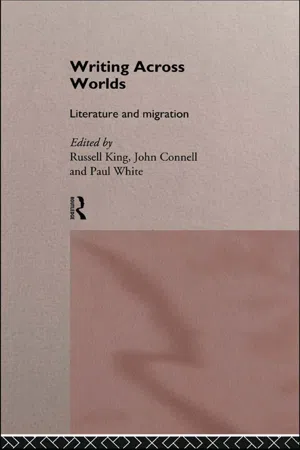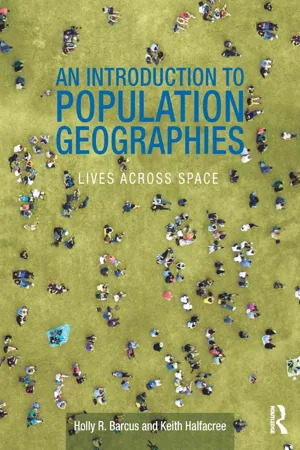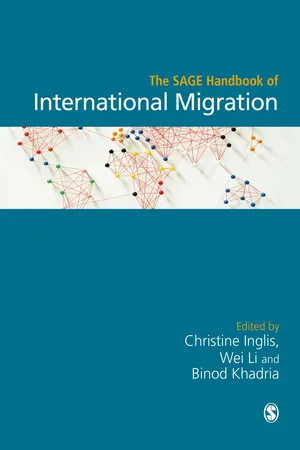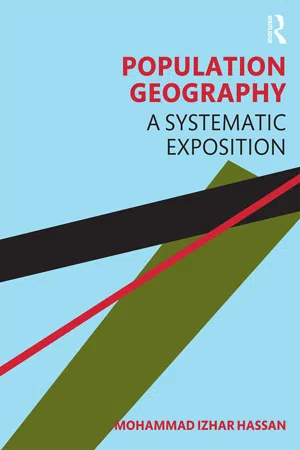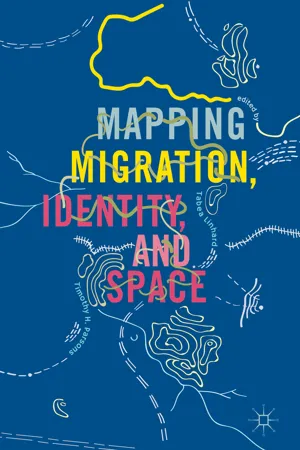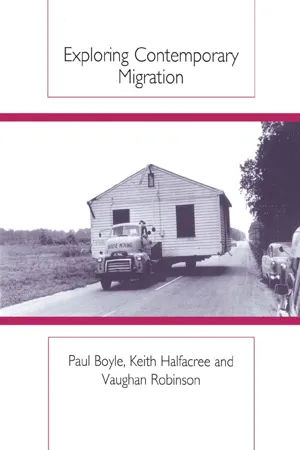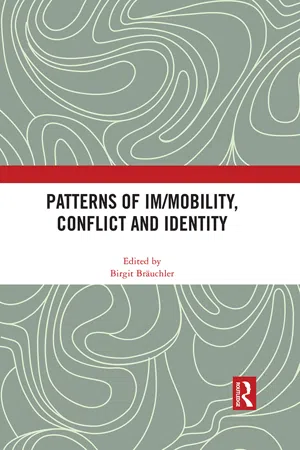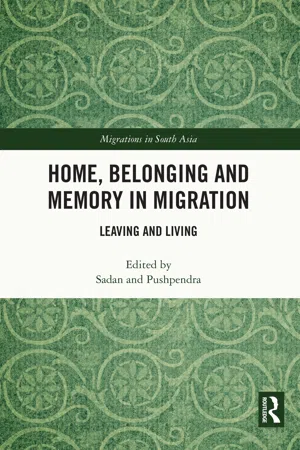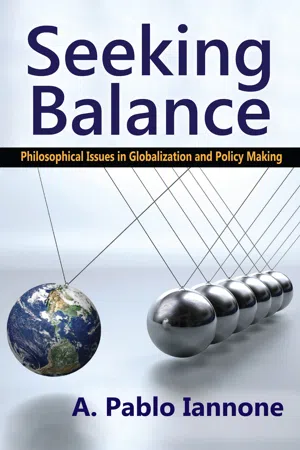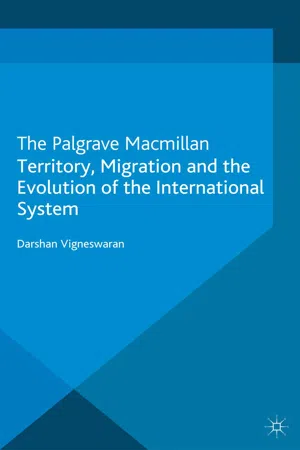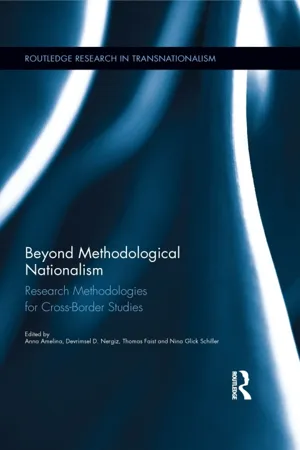Geography
Migration and Identity
Migration and identity are interconnected concepts that involve the movement of people from one place to another and the impact of this movement on their sense of self. Migration can influence individuals' cultural, social, and personal identities, as they navigate new environments and interact with different communities. This dynamic relationship between migration and identity is a key focus in the field of Geography.
Written by Perlego with AI-assistance
Related key terms
12 Key excerpts on "Migration and Identity"
- eBook - ePub
Writing Across Worlds
Literature and Migration
- John Connell, Russell King, Paul White(Authors)
- 2002(Publication Date)
- Routledge(Publisher)
1GEOGRAPHY, LITERATURE AND MIGRATION
Paul White1
INTRODUCTION
We live in what has recently been termed ‘The Age of Migration’.2 Geographical movement can be seen as a crucial human experience. Such movement occurs within a striking concatenation of economic, political, social and cultural circumstances which provide both structural forces driving mobility and also the controlling mechanisms that limit and channel the selection of people and places involved. These circumstances lie within the range of traditional social-scientific concerns for the aggregate forces and developments occurring within human populations.At the same time population movement transforms all the elements involved, not only in the structural circumstances that underpin migration systems, but also within the places and the people bound up in migratory experiences. Places of origin, of passage, and of destination of migrants are altered as a result of the flows of people that affect them. Transformations also occur in the lives of all those involved; not just the migrants themselves but also those who directly come into contact with them and those who, indirectly, are affected by social, political and economic changes induced by migration. The role of human agents is a determining one, but only within the structural context in which those agents are located.Migration therefore changes people and mentalities. New experiences result from the coming together of multiple influences and peoples, and these new experiences lead to altered or evolving representations of experience and of self-identity. Such representations are then manifest in cultural artefacts of many kinds—new forms of dress, of food cultures and of consumerism, new styles of music and of poetry, new political ideologies, new forms of literary production. All of these can be seen to have their own claims as authentic materials. However this book, and this introductory chapter, explore just one aspect of these representations—that of literary output—without seeking to privilege or prioritise this over other artefacts. - eBook - ePub
An Introduction to Population Geographies
Lives Across Space
- Holly R. Barcus, Keith Halfacree(Authors)
- 2017(Publication Date)
- Routledge(Publisher)
CHAPTER 5Placing human migration5.1 INTRODUCTION: DEFINING MIGRATION
5.1.1 What is migration?
Migration remains the most widely studied and examined element within Population Geography (Boyle 2003, 2004). Moreover, whilst Geographers have played a pivotal role in shaping our contemporary understanding of it, the topic is of interest to numerous academic disciplines, including Demography, Sociology, Political Science, Economics and Anthropology (Brettell and Hollifield 2008a). In this respect, approaching migration as it occurs within the life course has considerable potential for bringing together a scattered body of scholarship often fragmented by “disciplinary partitioning” (Olwig and Sørensen 2002: 7).But what exactly is migration? Initially put, as in a recent textbook, it is “the movement of people to live in a different place” (Holdsworth et al. 2013: 96) or a “permanent change in residence.” It is residential relocation. Or, as expressed in UK and US censuses, a migration is deemed to have occurred when one’s “usual address” has changed within the last 1 or 5 years, respectively (ONS 2013; USCB 2013). Simple, then, one might think! However, as Holdsworth et al. (2013: 98) also noted, careful consideration of these definitions immediately raises a host of questions: what precisely is meant by “different place,” “live in,” “permanent,” or “usual address”? Consequently, by the end of the present chapter, “migration” will have been demonstrated to be at least as complex and multi-dimensional a concept as Chapter 4 revealed “fertility” to be.Starting with the idea of “different place,” the type of areal unit(s) involved in a migration is an initial important consideration when defining it specifically. A crucial starting point is whether a political boundary is crossed during a move. For example, an individual could move from one county to another within the same US state or from one state to another. Both moves are conventionally described as intra-national or internal migration, because neither involves leaving the US. In contrast, a move from the US to Canada, crossing an international border, is an international migration - eBook - ePub
- Christine Inglis, Wei Li, Binod Khadria, Christine Inglis, Wei Li, Binod Khadria(Authors)
- 2019(Publication Date)
- SAGE Publications Ltd(Publisher)
8 Geography and Migration Emily SkopIntroduction
This chapter considers how geographers take account of the inherently spatial phenomenon of migration. First, the chapter discusses the unique spatial perspective that broadly makes geography an ideal discipline for studies of migration, including utilizing core spatial concepts like space, place, networks, movement, scale, and territory, as well as the discipline's methodological diversity, and its tendency towards interdisciplinary engagement. Second, the chapter focuses on the way the discipline of geography has conceptualized and examined migration through a discussion of key theoretical framings within the field, including neoclassical spatial analysis, the socio-spatial lens, and the geopolitical turn. Third, the chapter reflects on the major developing trends and debates in the discipline of geography with regards to migration studies, with an eye towards future research and interdisciplinary perspectives, with special attention given to ‘crisis’ migration as well as the mobilities paradigm.The Discipline of Geography
Migration – a process that evolves over space and time – involves the continual reshaping of space as persons move. Migration has risen dramatically in the past two centuries, and the result is constant transformation and dislocation, which in turn has prompted significant attention to the phenomenon by geographers. Indeed, geographers are especially interested in migration because it continually disrupts and remakes geography, as spatial linkages and interconnections both form and dissolve when people move. The socio-spatial patterns, causes, and consequences of migration are innumerable and include complicated, multi-scalar phenomena, all of which are studied by geographers.The geographical lens encourages a unique spatial perspective when it comes to the study of migration. While definitions have been highly contested and subjected to pages of debate, below are some generalities that pertain to migration studies. Among its most important differentiating features, the geographical lens (and the spatial perspective more specifically) is: - eBook - ePub
Migration Theory
Talking across Disciplines
- Caroline B. Brettell, James F. Hollifield, Caroline B. Brettell, James F. Hollifield(Authors)
- 2022(Publication Date)
- Routledge(Publisher)
Exploring Scalar, Spatial, and Placeful Dimensions of Human Mobility Marie PriceDOI: 10.4324/9781003121015-7Geography is a discipline closely associated with maps and spatial reasoning. Maps, especially thematic ones, challenge us to visualize spatial distribution of phenomena across space and over time at various scales. Anything that is unevenly distributed is eminently mappable and thinking in maps invites us to consider spatial arrangements. The varied movement of people has been an irresistible subject for geographical inquiry and theorization since the inception of the modern discipline. Why is a cluster of migrants located in one place and not another? How are clusters linked through networks and how do these distributions influence space and place? What structural or environmental forces are driving human mobility? Mapping forces one to select a scale of analysis; consequently, geographers have a proclivity to shift scales, from the local to the global, and even jump scale when necessary. Not limited to any single container of convenience, such as the territorial state, geographers consider various socio-legal containers when theorizing about migration from neighborhoods, to cities, to meta-regions such as Europe or Africa. Geographic scholarship is increasingly interested in how these containers are enforced, deformed, and reconstituted in response to migration. Finally, geography is concerned with a deeper understanding of context and placemaking, seeing space as layered with information such as: the physical environment, the ethnic composition of residents, and their socioeconomic well-being. Human mobility is often a response to and a catalyst for these layers, and thus the social and environmental contexts of areas of departure and reception invite geographical theorization.This chapter will consider some of the foundational theories that shape geographical understandings of migration and human mobility. It argues that, as a discipline, geography has a long-standing thematic interest in human migration, because the movement of people “continually disrupts and remakes geography, as spatial linkages and interconnections both form and dissolve when people move” (Skop 2019: 108). As international migration has intensified since the 1990s, geographic scholarship that empirically demonstrates these flows and theorizes their impact has steadily increased (Price and Benton-Short 2008; King 2012; Czaika and de Haas 2014; Winders 2014; Yeoh and Ramdas 2014; Ehrkamp 2017, 2019, 2020; Collins 2020). Theoretically, geographers have worked across disciplines, and have modified existing theories, as well as inserted innovative theoretical perspectives and methodological approaches. At the core of much of this work is a profound interest in explaining spatial patterns and human networks, as well as a sensitivity to scalar shifts and bordering practices. Human geographers offer theoretical insights about the migrant experience, limits to human mobility, practices of placemaking, development, and integration, as well as the intersectionality of gender, race, and class in understanding migration (Silvey and Lawson 1999; Carling 2002; van Riemsdijk 2014; Yeoh and Lam 2016). Because of geography’s inclination to examine the relationship between society and environment, there is also a growing research interest in the environmental drivers of migration, especially connected to climate change (Hugo 1996; Piguet 2010; Piguet, Kaenzig, and Guélat 2018; Jockish et al. 2019). - eBook - ePub
Population Geography
A Systematic Exposition
- Mohammad Izhar Hassan(Author)
- 2020(Publication Date)
- Routledge India(Publisher)
United Nations Multilingual Demographic Dictionary defines migration as ‘a form of geographical or spatial mobility between one geographic unit and another, generally involving a change in residence from the place of origin or departure, to the place of destination or arrival’. Thus, migration is different from other forms of mobility such as temporary movement of tourists, or frequent trips of people in business, or constant movements of nomads, or movement of students for the purpose of studies, or daily movement of commuters to place of work. These movements do not involve any permanent or semi-permanent change in the place of residence to qualify as migration.The study of migration occupies an important place in population studies, as together with fertility and mortality, migration determines the size, distribution and growth of population along with its composition and characteristics. As compared with the other two components, migration has been a more popular subject of interest for population geographers. Interestingly, demographers have paid very little attention to this component of population change. Population geographers have since long been concerned with the relationships between movement of people, distance and interacting areas (Woods, 1979:165). Along with its various demographic, social and economic effects, population geographers have also been concerned with the environmental influences upon migration streams and consequences in areas of departure and destination (Clarke, 1972:130).Mobility and migration: general terms and concepts
As noted previously, migration refers to permanent or semi-permanent change in the place of residence of an individual or a group of individuals from one location to another. Hence, it is different from the more general term mobility, which refers to all types of movements of people (Rubenstein and Bacon, 1990:75). Thus, the term mobility includes both permanent (and semi-permanent) and temporary movements of people over the earth. With regard to temporary movements, the examples of which have already been cited, a distinction is generally made between a cyclic and a periodic movement. A cyclic movement includes short duration trips to place of work (i.e. commuting), or frequent business trips of people in business, or movement of nomads, which is comparatively irregular in timing. A periodic movement, on the other hand, involves a longer period of residence away from home base than that in the cyclic movement (Blij and Muller, 1986:103). Periodic movement includes the movement of students away to other locations for the purpose of studies, or the movements of military personnel to military bases, training schools or combat zones. The movement of migrant labourers and their families is also periodic movement, although it is more cyclic than that of students or military personnel. Still another form of periodic movement is what is commonly known as transhumance - eBook - ePub
- Tabea Linhard, Timothy H. Parsons, Tabea Linhard, Timothy H. Parsons, Tabea Linhard, Timothy H. Parsons(Authors)
- 2018(Publication Date)
- Palgrave Macmillan(Publisher)
The synergies between these concepts are intense: identities are ‘placed’ and places have their own (contested) identities; identities are also about fluid borders (between ‘them’ and ‘us’); whilst the relationship between space and place is interlocking in the fashion of a Russian doll—spaces are made up of places which in turn contain micro-spaces and so on. This latter point is brilliantly explored by geographer Doreen Massey in her extensive writings on space and place. 7 Both places and spaces, at various scales, are inherently tied to identities and their formation, as well as being shaped by particular histories of social relations. These social dynamics may be shaped by Marxian relations of capital and labour, producing spaces and places which are feudal, industrial, or based on trade and commerce. For the people who live there, their sense of place is partly defined by these underlying structures of power. But these place - and region-based identities are fluid and contested. Migration is often a major part of these contested place identities, disrupting the ‘naturalised sense of place’ that some argue is part of one’s identity. And then there is time—both historical time and the varied temporalities of migration and mobility. Donna Gabaccia reminds us that migration, mobility and human spatial movement are fundamental norms of human history. 8 People have always moved, and there is no reason to believe that this mobility will stop, no matter how many walls and barbed wire fences are built by regimes and despots who fail not only to express a modicum of humanity to those less fortunate but also to grasp the fundamental historicity of migration and its basic economic, social and cultural drivers. Whilst there have been many histories of migration in the world, or in parts of it, the ‘timeness’ of migration has been understudied. 9 By this I mean how the very process and experience of migration unfolds in time (and space) - eBook - ePub
- Paul Boyle, Keith Halfacree, Vaughan Robinson(Authors)
- 2014(Publication Date)
- Routledge(Publisher)
CHAPTER 1Introduction: the spatial impact of migrationMigration as a feature of daily lifeAt first glance, writing an introductory text on migration seems to be a relatively straightforward task. Migration is a simple concept. People move between places and we are interested, as geographers, in describing and understanding these patterns. However, when you think about and study the topic in detail, it becomes clear that migration is, in reality, extremely complex and multi-faceted. This explains why there is such a large literature on migration in geography and other disciplines, and perhaps the hardest task is to order systematically such a diverse set of material in a logical and coherent manner. Migration includes international flows of large numbers of refugees stimulated by wars, famine or political unrest; young adults moving between regions in search of employment; middle-aged professionals moving back to the land in their search for a rural retreat; families moving down the road to satisfy changing housing requirements; and gypsies and other nomadic peoples for whom mobility is a way of life. Consequently, it is difficult to identify an optimum structure for a text such as this. Do we distinguish between different types of migration based on the distance moved? Do we stress the differences between broad regions or groups of countries, such as between the developed and developing world? Or do we identify the migration themes that underlie the different migration processes?We have adopted the latter structure. A thematic approach captures the migration experience because it relates directly to the varied underlying causes of migration. However, because particular migration events and individuals’ migration experiences do not fall into neat categories, inevitably there is considerable overlap between any themes that we focus our attention on. As we demonstrate in this book, the act of moving rarely involves one factor, even if the move is motivated primarily by one overriding issue. Rather migration is firmly embedded within the complexity of people’s everyday lives and experiences. Indeed, migration decisions are often influenced by factors that are much less obvious than might appear at first sight. Such an appreciation of the embeddedness of migration within daily life was captured by Chambers (1994: 2) when he observed that ‘migration … is … deeply inscribed in the itineraries of much contemporary reasoning’. It is with the processes bringing about this inscription that this book is primarily concerned. - eBook - ePub
- Birgit Bräuchler(Author)
- 2021(Publication Date)
- Routledge(Publisher)
Some of the papers illustrate the construction of such cultural repertoires, which allow for the re-grounding of identities in a specific space, while linking those to an imaginary of mobility. Local belonging thus becomes mediated through specific narratives that put mobility at the centre. Bedert (2017), for example, emphasizes the existence of a distinct historical imagination related to regional mobility among the Mandingo in Liberia and points to the role of ‘imaginaries of mobility’ in creating group identity at a regional and local level. Sakti (2017), in her contribution, reveals the emergence of narratives of mobility across borders (or the impossibility to cross) and the way these narratives render group identities and webs of social relationships meaningful. The construction of identity and belonging in mobile contexts is highly ambiguous, as it involves an emotional side that scholars of transnationalism have clearly highlighted. Conradson and Mckay (2007, p. 167) point to the importance of studying ‘the self as a relational achievement’, as diverse forms of subjectivity emerge from geographical mobility, different locations and social connections at a local level. International migration is supported by feelings of expectation, joy, excitement but also rupture, loss, pain due to family separation, nostalgia, and the feeling of obligation and longing towards one’s family (Conradson & Mckay, 2007). In a new place, migrants also go through ‘emotional adjustment’ (Chamberlain & Leydesdorff, 2004). Historical factors, social structures and cultural contexts, such as the presence of a large community of compatriots in the host society, likewise influence an individual’s decision to migrate and to adopt a new identity or a new place as ‘home’ (Aranda, 2003, p. 15). Similarly, a ‘sense of family’ with relatives back home is built across distance through various rituals, such as family reunions, which influence individual perceptions of belonging (Svasek, 2010, p - eBook - ePub
Home, Belonging and Memory in Migration
Leaving and Living
- Sadan Jha, Pushpendra Kumar Singh, Sadan Jha, Pushpendra Kumar Singh(Authors)
- 2021(Publication Date)
- Routledge India(Publisher)
Although engendering the migration largely remained un-attentive to questions of subjectivities of women migrants or those who stayed behind/left behind and their desires and sufferings, the discourse questioned numerous settled stereotypes and frames of understanding migration. For example, when the debate on the nature of modernity in India acquired momentum in Indian social sciences, migration came to be acknowledged as an important vehicle for the ideas and commodities linking different geographies and shaping gender and other social relations. In the words of Gidwani and Sivaramakrishnan,to critique Modernity through the lens of movement and migration is to ‘question a pre-given world of separate and discrete “peoples and cultures” and see instead a difference-producing set of relations….(Gidwani and Sivaramakrishnan 2004 : 346)Migration and rural cosmopolitanism, Gidwani and Sivaramakrishnan (2004) argue, decisively influence self-making, consumption culture, women’s “self-conception of goods and values that are modern” (p. 353), a preference for women workers in informal and “underground” sectors like that of information technology and garments leading to a scenario when “it is now men who are being sidelined” (p. 352).The decade of 1990s, when migration studies was undergoing the process of engendering and moving its focus from the collective to individual narratives of pain and suffering, also witnessed a renewed scholastic vigour in the conceptualisation of diasporic/overseas migration and the problematisation of identity connected with it. Building upon the works on post-structuralism, in the fin de siècle, postcolonial theorists like Homi Bhabha provocatively questioned the very location of culture and its sedentariness to make a case for the hybridity of emigrant identity and a conceptualisation of the contemporary conditions of living “beyond” the borders (Bhabha 1994 : 1).5 - eBook - ePub
Seeking Balance
Philosophical Issues in Globalization and Policy Making
- A. Pablo Iannone(Author)
- 2017(Publication Date)
- Routledge(Publisher)
15Globalization, Migrations, and Personal Identity *The poet and philosopher George Santayana once asked, “What is life but a form of motion in a journey through a foreign world?”1 Santayana’s question may have relied heavily on metaphor when he asked it; in view of the growing early twenty-first-century migrations, however, its meaning is not just metaphorical. It is hard to quantify precisely the size of current migrations, but it is estimated that as of this writing, in 2012, more than two hundred million people are living outside their country of citizenship.2 They are often called “expatriates,” whether they are individuals working abroad on temporary assignments, lifestyle migrants that move abroad in search of a better way of life, pensioners that move to warmer countries because of the climate and lower cost of living, international students studying abroad, or people who move abroad so they can improve their standard of living or simply be free from political persecution or other dangers. That is, in this overarching sense of “expatriate,” the degree and nature of the choices that expatriates have in becoming expatriates vary significantly—for some, these choices are limited by threats or poverty, and for others, only by personal projects and opportunity.Whatever the choices open to them, expatriates typically approach their host cultures with a distant, often critical eye, wondering about what everyone else takes for granted. At the same time, they must adapt, hence somehow change, which prompts many of them to wonder about what they themselves take for granted and, as a result, to sometimes develop a self-unsettling sense of identity and an unsettled or substantially changed identity. In this chapter, I will focus on this aspect of expatriation and ask the following questions: What is the expatriate experience? How does it differ from the experience of being a stranger? Under what conditions does it undermine an individual’s personal identity? What does it entail, if anything, regarding the nature and grounds of personal identity and the personal certainty that an individual’s sense of self tends to carry with it? How extensive are its effects, especially concerning people’s self-esteem, and what, if anything, should individuals and societies do about them? I will argue for four theses. First, some of the salient characteristics of the expatriate experience are typically (though not universally) critical wonder, feelings of estrangement, and a mixture of melancholy and exhilaration. Second, the expatriate experience involves 1) ambiguity about one’s remembered, imagined, or hoped-for homeland; 2) a fluid transculturational balance—that is, a changing equilibrium in the expatriate’s interactions with and adaptations to his or her foreign environment; 3) a heightened awareness of local conventions; and 4) an increased reliance, as expatriates respond to their foreign environments, on convention-settling procedures—that is, social decision procedures, from argument and negotiation to quiet resistance and outright confrontation—whose aim is to settle new conventions in the expatriate’s encounter with foreign environments. Third, expatriates’ reliance on convention-settling procedures is often displayed in response to the personal effects—for example, those tending to undermine their personal identity—that ongoing globalization processes have on them. Fourth, convention-settling procedures promise to be of help in enabling us to deal fruitfully (i.e., more intelligently and practically) with globalization problems and issues—in particular, with the problem of adapting to changes brought about by globalization—without thereby sacrificing our personal identity or our sense of self. - D. Vigneswaran(Author)
- 2013(Publication Date)
- Palgrave Macmillan(Publisher)
Taking our cue from immigration policy, we have almost always conceptualized migration as a ‘problem’ and state territoriality as its ‘response’. We largely confine discussions of ‘migration’ to reflections on the permanent immigration of people into a national jurisdiction and commonly restrict our analysis of ‘territoriality’ to studies of the defences that nation states use to exclude immigrants at their borders or to expel them from within. 4 Such a perspective speaks – quite directly and succinctly – to the policy concerns of many immigration departments, and in this respect research has been commonly credited with the creation of useful knowledge. 5 At the same time, this approach also leaves out, or renders unimportant, a range of important relationships between human mobility and geopolitical power that are essential to a full appreciation of both the historical specificity of contemporary policies and the immanent potential for fundamental change. For example, in emphasizing the way states prevent migration, we often ignore all of those situations in which political institutions have actively fostered long-term and large-scale movements of people. Take, for example, the British Empire’s sponsorship of migration to its colonies or conversely, the way Hitler’s Germany actively fostered the flight of Jewish residents in wartime Europe. 6 These are clearly territorial strategies for controlling migration, but they do not involve efforts to prevent, but rather to instigate and promote migratory processes. These sorts of approaches are not merely evident in the past. They appear to animate how states seek to control migratory processes in the present day. For example, contemporary African states seek to promote development by encouraging the growth of their immigrant diaspora- eBook - ePub
- Anna Amelina, Devrimsel D. Nergiz, Thomas Faist, Nina Glick Schiller, Anna Amelina, Devrimsel D. Nergiz, Thomas Faist, Nina Glick Schiller(Authors)
- 2012(Publication Date)
- Routledge(Publisher)
One might expect that since migration is about movement across space, the transnationality of cities would be obvious within migration studies. This has not been the case. There is a vast scholarship of migration that describes the, ways in which migrants live in cities. Increasingly this work has examined the social relations and identities that migrants maintain and construct as they live across borders and “simultaneously” settle into a new life and become reterritorialized (Levitt and Glick Schiller 2004). However, there has been too little comparative work done to examine the migrants’ varying relationships to the positioning of cities. This is because migration scholars have been hindered by their methodological nationalism and ethnic lens (Glick Schiller and Çağlar 2009). Methodological nationalism is an intellectual orientation that approaches the study of social and historical processes as if they were contained within the borders of individual nation-states (Beck 2000 ; Smith 1983 ; Wimmer and Glick Schiller 2002). The term ethnic lens refers to the propensity of migration researchers to rely on ethnic boundaries to define the unit of study and analysis in research on immigrant settlement and transnational connection (Glick Schiller, Çağlar and Guldbrandsen 2006). As a result of methodological nationalism and the ethnic lens, research-ers often approach the terrain of the nation-state as a single homogenous national culture, while defining a migrant population as a community of culture, interest and identity
Index pages curate the most relevant extracts from our library of academic textbooks. They’ve been created using an in-house natural language model (NLM), each adding context and meaning to key research topics.
